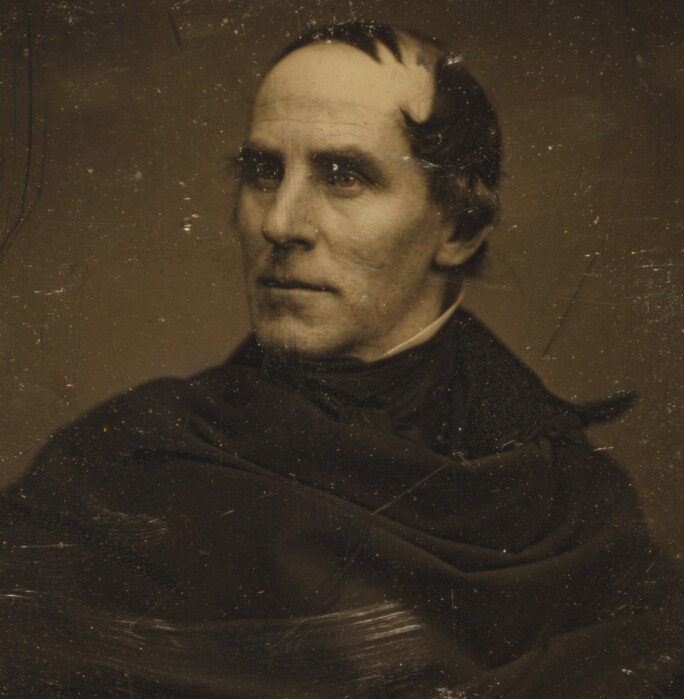About the Hudson River School
What is the Hudson River School?

Among the most vivid and dramatic works of the 19th century, the Hudson River School's sweeping canvases captured the rugged sublimity of the American landscape and memorialized the heady era of manifest destiny. As with so many other pioneering historical art movements, the name Hudson River School was first used disparagingly, by voguishly Europhile critics who favored the dignified realism of L'École de Barbizon. Largely neglected by the turn of the 20th century, a series of exhibitions and the revival of the Hudson Valley region in the 1960s and 1970s reignited interest in the School, and today its exuberantly romantic vision of nature and man's peaceable communion with it is highly esteemed by scholars and collectors alike.
What Are the Stylistic Characteristics of the Hudson River School?
The masterpieces of the Hudson River School powerfully convey the natural grandeur of the New World – not just the Hudson River Valley, as the name would imply, but also the Catskills, Adirondacks, White Mountains, the Maritimes, the American West and South America.
The paintings themselves tend toward the monumental; Albert Bierstadt's Domes of Yosemite (1867), for example, measures 15 feet in width. If human figures are included in these compositions, they exist to emphasize the sheer magnitude of their wild surroundings. The Hudson River School artists also eschewed neoclassical symmetry and balance in favor of jagged lines that suggest latent energy and dynamism.

An Influential Canadian Foray
Robert Seldon Duncanson, a second-generation Hudson River School painter descended from freed slaves in Virginia, exiled himself in Canada during the Civil War. While in Montreal, Duncanson made many monumental paintings and developed fruitful connections within the Canadian art scene. He is credited as catalyzing the creation of the first Canadian school of landscape painting, which would be carried forth by artists such as Otto Jacobi, Allan Edson and John Fraser after Duncanson's return to the United States. Duncanson's preeminent Canadian landscape, Owl's Head Mountain (1864) is displayed in the National Gallery of Canada in Ottawa.
What is the Legacy of the Hudson River School?
The Hudson River School directly influenced the style of landscape painting known as luminism, characterized by its contemplative treatment of light, water and atmosphere. Its principal exponents included Fitz Henry Lane and Sanford Robinson Gifford, who were active concurrently with the second generation of the Hudson River School. These artists, in turn, have inspired numerous contemporary painters in the pursuit of rarefied candescence; Stephen DaLuz and April Gornik are among the living artists whose work has been termed “neoluminist.”

The work of the original Hudson River School masters can be seen in numerous public institutions, principally in the northeastern United States. Among the largest collections is at the Wadsworth Atheneum in Hartford, Connecticut, the hometown of Frederic Edwin Church. Other collections of note are the Fenimore Art Museum in Cooperstown, New York; the Mabee-Gerrer Museum of Art in Shawnee, Oklahoma, and the Berkshire Museum in Pittsfield, Massachusetts.
Read Less
Timeline & History

Thomas Cole; portrait Asher B. Durand, 1837 1825Thomas Cole takes a steamship up the Hudson in preparation for his first montane painting expedition.
A self-portrait by Asher Brown Durand, circa 1835 1837Thomas Cole and Asher B. Durand embark on a sketching expedition in the Adirondacks.
Frederic Edwin Church, circa 1855 – 1865 1848Thomas Cole dies; a second generation of Hudson River School painters begin to gain fame and fortune.
John Frederick Kensett, Mount Washington from the Valley of Conway, 1851 1851John Frederick Kensett paints Mount Washington from the Valley of Conway, which was widely reproduced as an engraving and popularized the White Mountain region of New Hampshire.
Frederic Edwin Church, South American Landscape (Study for Chimborazo), circa 1856-57 1853Inspired by Alexander von Humboldt's exploration of South America, Frederic Edwin Church makes the first of two trips to the continent.
Susie M. Barstow, Sunshine in the Woods, circa 1865 1858Susie M. Barstow begins to exhibit at the National Academy of Design.
Albert Bierstadt, Yosemite Valley, 1865 1867Albert Bierstadt begins a two-year junket through Europe, exhibiting paintings that spark an interest in the American West.
Sanford Robinson Gifford, A Lake Twilight, 1861 1880Sanford Robinson Gifford's landscapes, now often termed “luminist,” are the subject of a major memorial retrospective at the Metropolitan Museum of Art.
Thomas Moran, The Three Tetons, 1895 1895Thomas Moran paints The Three Tetons, now in the collection of the White House.
Albert Bierstadt 1902Albert Bierstadt dies, largely forgotten, the public's enthusiasm for epic landscape painting having waned.
Artists
Who Was Part of the Hudson River School?
The British-born painter Thomas Cole is widely acknowledged as the founder of the Hudson River School, having hiked high into the Catskill Mountains of New York State to paint the first landscapes of the region in 1825. Cole's American friend Asher Durand was also a pioneering figure in the movement; the two co-founded the National Academy of Design that same year. A second generation of Hudson River School artists rose to prominence after Cole's early death in 1848. Chief among these were Frederic Edwin Church, John Frederick Kensett and Albert Bierstadt, whose unprecedentedly-expansive vistas drew crowds of thousands willing to pay a quarter to get a glimpse. The Hudson River School is also notable for its inclusion of women in both education and exhibition. Susie M. Barstow was an experienced all-season mountain climber who exhibited her paintings of the Appalachian's high peaks at the National Academy of Design, while Julie Hart Beers's riparian scenes sold plentifully and made her one of the few commercially successful women artists of her day.
Hudson River School Artists
The Hudson River School at Auction
The Hudson River School at Auction
Sell
Have Something to Sell?
Have Something to Sell?
Get Started
























